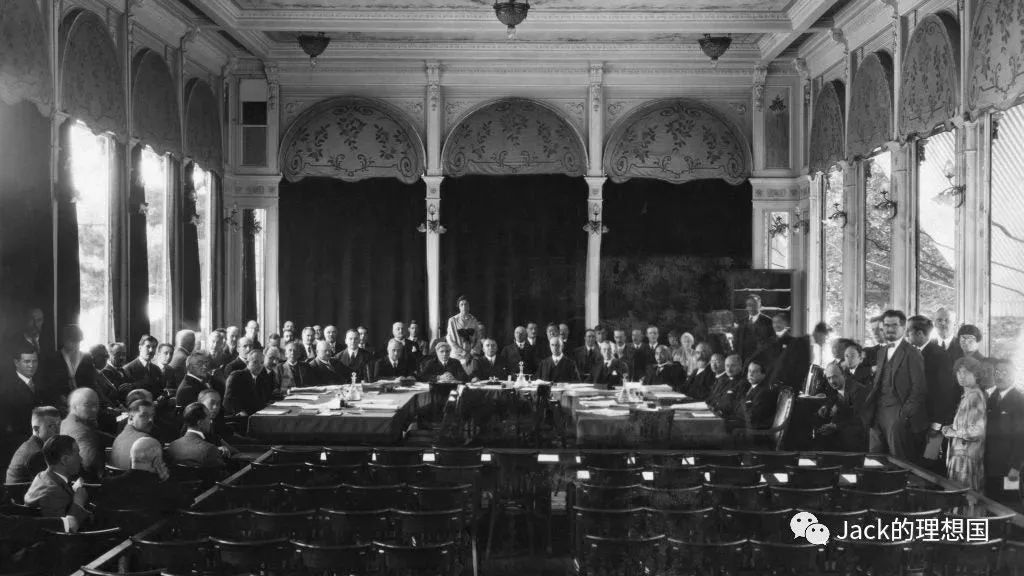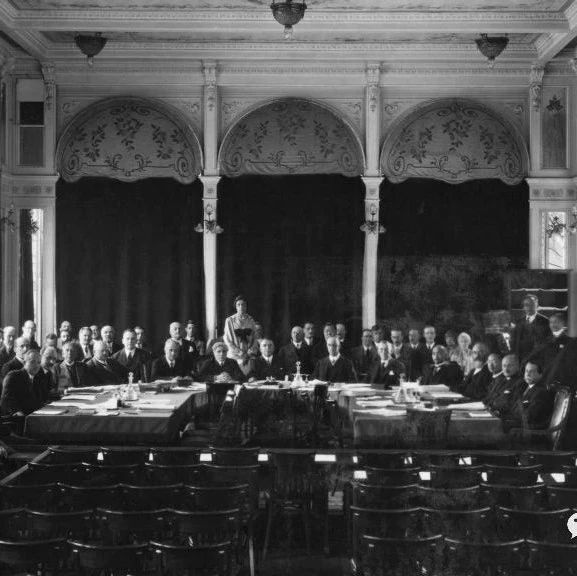Links Between East and West 49 Controlling War 东西方的连接49 - 控制战争

(The League of Nations, the organization formed after World War I to check warmongering action)
(国际联盟,第一次世界大战后成立的国际组织,其核心目的便是控制战争冲动与行为)
Regulating Warfare, A Domestic Approach
Introduction
Ever since the most modern wave of globalization swept across the world during the nineteenth and early-twentieth centuries, the topic of controlling warfare and bringing about long-term peace has topped the agenda of world leaders consistently. Although leaders have attempted to resolve the problem by focusing on how states interact with each other on the international stage, their attempts have not yet withstood the test of time. Human decisions determine the frequency and severity of warfare. Hence, unless governments can somehow alter or significantly influence human decision-making effectively over time, warfare will always be a recurring phenomenon through history.
This essay will take an alternative approach to examine the controlling of warfare. Contrary to the popular route of thinking that emphasizes the importance of international relations in this topic, this essay will propose that it might be equally useful to study states in isolation. The essayist will argue that to effectively control warfare, states should concentrate more on their own domestic statuses and development.
Nomadic and Sedentary Civilizations
Before the argument sets in, it is first pertinent to establish some relevant context that will be called upon in later sections. Two of the most vital concepts that must be understood are nomadic and sedentary civilizations. For a nomadic civilization, at its heart, as the name suggests, its members live a life that is not particularly bounded by a certain area of land. People in nomadic civilizations roam around, sometimes seasonally or even daily. Generally, to the opposite of a nomadic civilization lies a sedentary civilization. By definition, a sedentary civilization fixes itself onto an area of land and develops from that original “base.”
Following the Cognitive Revolution 70,000 years ago, humans coalesced into hunter-gatherer societies. These societies or clans largely were nomadic - they moved around seasonally in search of food and a better climate. By 12,000 years ago, when the Agricultural Revolution began, an increasing number of societies abandoned their nomadic lifestyle and adopted a sedentary one that revolved around their agriculture. What followed was an unstoppable wave of development that resulted in almost every civilization evolving into a sedentary one. Nomadic civilizations are more “self-vibrant.” That is, they are more self-sufficient in terms of their consumption of resources; they have a more “fluid” society that possesses mobility; they revolve around a simple and yet original and powerful culture. Compared to nomadic civilizations, sedentary ones are less “self-vibrant.” They are less self-sufficient and rely increasingly more on each other for economic needs; they have a far more complex social hierarchy that can “freeze” individuals at certain levels, obstructing social mobility; they spin around a culture that possesses far more branches and is complicated to the degree where cultural elements can clash with one another. The comparison above is not to say that sedentary civilizations are inferior to nomadic civilizations. The author only adopted a small set of standards for comparison that is only useful for the purposes of this article. However, the claim that sedentary civilizations are less vibrant internally in many aspects does possess some merit.
In the subject of war, sedentary civilizations are much more violent than nomadic ones. As states settle down, it is only natural for them to keep developing a more complex society. The more complexity a society becomes, the easier it will be to create conflicts and hence the will to warfare. Nomadic civilizations can still be warmongers, as the example of the conquest wars of the Mongolians during the twelfth and thirteenth centuries shows. But such wars were shorter, more small-scale, or less frequent when compared to other wars fought during the same rough period between sedentary civilizations. Nomadic civilizations, because they are more self-vibrant and self-sufficient, do not often have such a strong will to incessantly subjugate others and keep perfecting the art of waging a war. Nor do they develop such complicated societies that have such high an internal tension that it is impossible for them not to wage external wars to release that tension.
The Case for the Modern Civilizations
For the modern sedentary civilizations, to prevent the outbreak of large-scale and frequent wars, it is imperative for their leaders to take inspiration from nomadic civilizations. States today can only control war if they are far more self-vibrant, if they exhibit far more vitality within. Self-vibrance may increase self-sufficiency and potentially provide a disincentive for any state to utilize warfare as an instrument to resolve internal issues. A group of states that are entangled in an array of domestic political, economic, and social ailments and are hence “dead” inside does not have any hope in stopping warfare. Governments should devote far more effort not necessarily on the interaction with other states on the international level but rather on schemes and attempts to increase the self-vibrance of their domestic states.
To make a state more self-vibrant requires a government to coordinate their investment of time, finance, and manpower in the various domestic sectors of a nation. Begin with the economy. To boost the self-vibrance of a state, the government should encourage local economic innovation and research. Governments should not aim to directly copy-and-paste a model of the economy from another nation, and instead should take a greater initiative to create an economic model that is based more on the internal conditions of the state. Many economies in the current world are underperforming because they are running an economic system devised elsewhere without possessing the same prerequisites needed to run that system. Another facet of local economic innovation is to encourage economists to identify and solve domestic issues by themselves. It is more to the benefit of the state if the government has a group of economists who specialize solely on the economic situations of the country. The government should also incentivize the average citizen to pay greater attention to the potential problems of the domestic economy and think more on the local level, not necessarily on the international one. Through such a way, the ingenuity of a human being can be kindled and emphasized. It can be easier to produce an economy that has more energy and flexibility when confronted with issues.
To make a self-vibrant state further requires domestic social reform. Currently, most societies are deeply divided. Divisions are caused by low social mobility and increasingly wide opinion gaps between different groups. Such a deeply divided society bodes ill for peace. Governments need to rethink how societies should be organized and where they should head towards. To increase social mobility, the government should first aim to break the most significant barriers between social groups, whether that is the discrimination towards the low-income or people who come from poor backgrounds or the unfair competition faced by less affluent individuals in the job market. The government should additionally equip the poor and those who do not have ample opportunities with the tools of modern technology. Especially with the rapid development of artificial intelligence, governments should consider how to make AI accessible to everyone so that a society, as a whole, can transcend some of the boundaries of knowledge that previously set apart social groups. Furthermore, the government should aim to build a society with more centripetal force, one that is united to a common purpose. This aim is arguably the most daunting task. A society that is more self-vibrant must be more closely knitted with more micro-connections between individuals.
Finally, to create self-vibrance means to display a culture that is simple yet flexible. The culture must be able to regenerate and adapt itself to the changing surrounding conditions. These abilities require the culture to be simple, possess significant traits that can be easily recognized and distributed, and develop small “segments” like receptors that can react to changing circumstances. The government should first aim to preserve traditional culture. For many countries, their traditional culture possesses many facets and a great depth. To preserve, hence, means to identify cultural symbols that can record the greatest amount of cultural information. Then, it is vital to dissipate these symbols so that they can be known and upheld by all members of a culture. Another difficult task is to make a culture always reactive to the changes of the status quo. The modern culture must absorb the impacts brought by the artificial intelligence revolution and be open and flexible. Governments and the citizens should try to innovate traditional culture, to blend it into modern social media and use technology to breathe new life into it. Such efforts are already being implemented in China, where traditional cultural elements are being popularized on electronic social media and given modern fragments.
From the above arguments, to build a self-vibrant civilization requires the consistent effort of the government in the economic, social, and cultural areas. When civilizations become self-vibrant, they are capable of reducing some of the internal conflicts that may lead to the waging of external war. When civilizations are self-vibrant and self-sufficient to a degree, they will not be so incentivized to wage wars for economic and political greed. Thus, the path forward to control war is not just about establishing international frameworks to check warmongering action. It is also equally about persuading governments to focus inwards on themselves and devote effort to make their economy, society, and culture truly sustainable. Undoubtedly, the most daunting hurdle is the Thucydides Trap – when dominating nations, out of fear, subjugate developing nations through warfare. If the Thucydides Trap exists, then it is more difficult for the smaller nations to become self-vibrant. Hence, overcoming the Thucydides Trap is of paramount importance for the international community. To be continued…
现代社会如何控制战争?
导言
自从 19 世纪与20 世纪初最现代的全球化浪潮席卷世界以来,控制战争并实现长期和平的议题就一直是世界领导人议程上的首要议题。尽管各国领导人都试图通过关注各国如何在国际舞台上互动来解决问题,但他们的尝试尚未经受住时间的考验。人类的决策决定了战争的频率和严重程度。因此,除非各国政府能以某种方式改变或显著影响人类的决策,否则战争将永远是历史上反复出现的现象。
关于如何控制战争,本文将另辟蹊径。与强调国际关系在这一主题中重要性的流行思路相反,本文将提出,孤立地研究国家可能同样有用。作者认为,要有效控制战争,国家应更多地关注自身的国内状况与发展。
游牧文明与定居文明
在开始论证之前,首先要建立一些相关的背景,在后面的部分中将会用到。游牧文明与定居文明是必须理解的两个重要的概念。就游牧文明而言,顾名思义,其核心是其成员的生活并不特别受某块土地的限制。游牧文明中的人们四处迁徙,有时是季节性的,有时甚至是每天都在进行。一般来说,与游牧文明相对的是定居文明。顾名思义,定居文明将自己固定在一片土地上,并从最初的 "基地 "发展起来。
七万年前的认知革命之后,人类凝聚成狩猎-采集社会。这些社会或氏族大多是游牧民族--他们为了寻找食物和更好的气候而季节性迁移。到了 1.2 万年前,农业革命开始后,越来越多的社会放弃了游牧生活方式,转而采用以农业为中心的定居生活方式。随之而来的是势不可挡的发展浪潮,几乎所有的文明都演变成了定居文明。游牧文明更具 "自我活力"。也就是说,他们在资源消耗方面更加自给自足;他们的社会更加 "流动";他们围绕着一种简单而又原始、强大的文化。与游牧文明相比,定居文明的 "自我活力 "较弱。它们不那么自给自足,经济需求越来越依赖彼此;它们的社会等级制度要复杂得多,可能会将个人 "冻结 "在某些等级上,阻碍社会流动;它们围绕着一种文化旋转,而这种文化拥有更多的分支,复杂到文化元素可能相互冲突的程度。上述比较并不是说定居文明不如游牧文明。作者只是采用了一小套比较标准,仅供本文参考。不过,关于定居文明在许多方面内部活力较弱的说法确实有一定道理。
就战争而言,定居文明比游牧文明更加暴力。随着国家的定居,社会自然会不断发展得更加复杂。社会越复杂,就越容易产生冲突,从而引发战争。游牧文明仍然可能是战争狂魔,蒙古人在十二和十三世纪的征服战争就是一个例子。但与同一时期定居文明之间发生的其他战争相比,这些战争的时间更短、规模更小、频率更低。游牧文明由于更加自强自立,往往没有那么强烈的意愿去不断征服他人,不断完善发动战争的艺术。他们也不会发展出如此复杂的社会,内部冲突如此之大,以至于不可能不发动对外战争来释放这种张力。
现代文明的案例
对于现代定居文明而言,要防止大规模频繁战争的爆发,其领导人必须从游牧文明中汲取灵感。今天的国家只有更加表现出更强的内在自我活力,才能控制战争。自我活力可以提高自给自足的能力,并有可能抑制任何国家利用战争作为解决内部问题的工具。一个被国内政治、经济和社会问题缠身,因而内部 "死气沉沉 "的国家是没有希望停止战争的。各国政府不一定要在国际层面上与其他国家进行过多的互动,而是应该在提高国内平衡能力的计划和尝试上投入更多精力。
要提高国家的自我活力,政府就必须协调其在国内各部门投入的时间、资金和人力。首先是经济。要提高一个国家的自我活力,政府应鼓励当地的经济创新和研究。政府的目标不应是直接复制粘贴别国的经济模式,而应更主动地创造出更符合本国国情的经济模式。当今世界许多经济体之所以表现不佳,是因为它们运行的是其他地方设计的经济体系,而不具备运行该体系所需的先决条件。地方经济创新的另一个方面是鼓励经济学家自己发现和解决国内问题。如果政府拥有一批专门研究本国经济状况的经济学家,这对国家更有利。政府还应该激励普通公民更多地关注国内经济可能存在的问题,更多地从本地层面考虑问题,而不一定要从国际层面考虑问题。通过这种方式,人的聪明才智、创新力可以得到激发与重视。在面对问题时,更容易产生更有活力和灵活性的经济。
要建立一个自我充满活力的国家,还需要进行国内社会改革。目前,大多数社会都存在严重分化。造成分裂的原因是社会流动性低,不同群体之间的意见差距越来越大。这种严重分化的社会对和平来说是个坏兆头。政府需要重新思考社会应该如何组织,社会应该向何处去。要提高社会流动性,政府首先应致力于打破社会群体之间最显著的障碍,无论是对低收入者或出身贫寒者的歧视,还是较不富裕者在就业市场上面临的不公平竞争。此外,政府还应为穷人和没有充分机会的人提供现代技术工具。特别是随着人工智能的快速发展,政府应考虑如何让每个人都能接触到人工智能,从而使整个社会能够超越过去将社会群体区分开来的一些知识界限。此外,政府应致力于建设一个更具向心力的社会,一个为共同目标而团结的社会。这个目标可以说是最艰巨的任务。一个更具自我活力的社会必须更加紧密地联系个人之间更多的微观联系。
最后,创造自我活力意味着要展示一种简单而灵活的文化。文化必须能够再生,并使自身适应不断变化的周围环境。这些能力要求文化简洁,具有易于识别和传播的重要特征,并形成像接收体一样的小 "片段",能够对不断变化的环境做出反应。政府首先应保护传统文化。对许多国家而言,其传统文化具有多面性及深刻性。因此,保护意味着找出能够记录最多文化信息的文化符号。然后,将这些符号传播出去,让文化的所有成员都能了解和维护它们,这一点至关重要。另一项艰巨的任务是让文化始终对现状的变化做出反应。现代文化必须吸收人工智能革命带来的冲击,并保持开放和灵活。政府与民众应努力创新传统文化,将其融入现代社交媒体,并利用现代科技为其注入新的活力。这种努力在中国已经开始实施,传统文化元素正在电子社交媒体上得到普及,并被赋予现代碎片化的特征。
从以上论点来看,要建立一个具有自我活力的文明需要政府在经济、社会与文化领域的持续努力。当文明具有自我活力时,就能够减少一些可能导致对外战争的内部矛盾。当文明在一定程度上实现了自我繁荣与自给自足,它们就不会有那么大的动力为了经济和政治上的贪婪而发动战争。因此,控制战争的前进道路不仅仅是建立国际框架来遏制战争狂魔国家的行动。这条道路上也同样需要说服各国政府关注自身,努力使其经济、社会和文化真正实现可持续发展。毫无疑问,最令人生畏的障碍是 "修昔底德陷阱"--当霸权国家出于恐惧通过战争打压发展中国家时。如果存在修昔底德陷阱,那么小国就更难实现自我繁荣,拥有自我活力。因此,克服修昔底德陷阱,重新确立国际间交流的规律对国际社会至关重要。未完待续...
- 本文标签: 原创
- 本文链接: http://www.jack-utopia.cn//article/623
- 版权声明: 本文由Jack原创发布,转载请遵循《署名-非商业性使用-相同方式共享 4.0 国际 (CC BY-NC-SA 4.0)》许可协议授权










